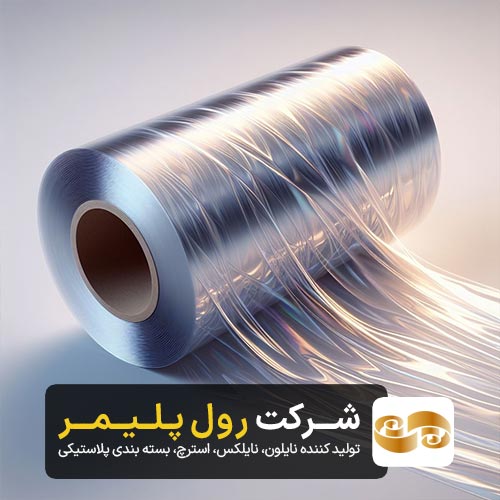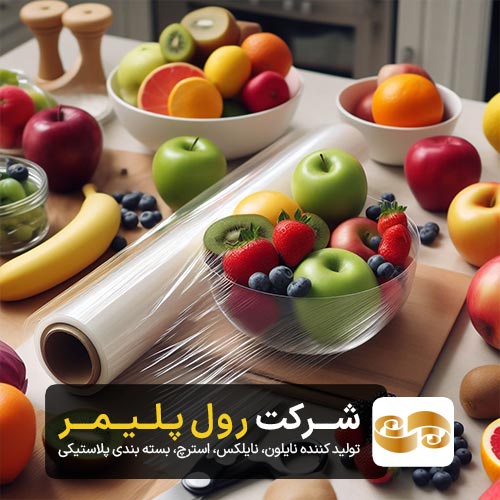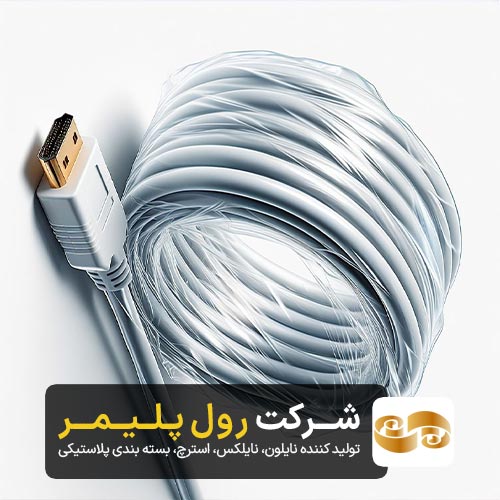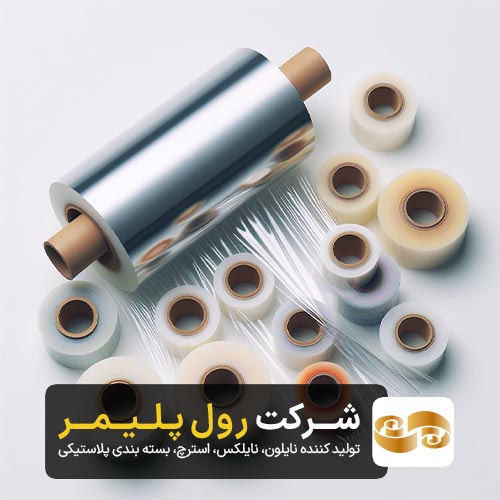
Cellophane
Cellophane is a type of transparent polymer film that is produced from light polyethylene and is used to package various materials in various industries, including the food industry, pharmaceutical industry, and social materials.
Uses of cellophane:
- Food packaging such as bread, fruit, vegetables and other products
- Pharmaceutical and medical product packaging such as pills and pharmaceutical packages
- Use in printing and packaging industries for packaging books, magazines and other printed materials
- Packaging gifts and other objects on occasions and celebrations
- Using in manufacturing and packaging industries of manufactured and handmade products
Packaging of products for distribution in the market uses several methods. One of the efficient and useful methods of packaging is the use of shrink wraps, which package the products in a number together. Shrink cellophanes are a special type of plastic that, when heated, change their shape to the shape of the packaged product and actually perform the vacuuming action.
Types of cellophane and their uses
Cellophane is a type of transparent and flexible plastic that is used in the packaging of various products. There are different types of cellophanes, each of which has its own characteristics and uses:
- Shrink Wrap:
- Shirink cellophanes are one of the most popular types of cellophane for packaging products
- This type of cellophane shrinks to the shape of the packaged product using heat, thus creating a tight and protective package
- Shirink cellophane applications include food, electronic, industrial and even toys packaging
- Polyethylene cellophane (Polyethylene Wrap):
- This type of cellophane is very suitable for packaging food products and drinks due to its flexibility and moisture resistance
- Polyethylene cellophane is widely used in the packaging of crushed food, such as bread, fruits and vegetables
- Polypropylene cellophane (Polypropylene Wrap):
- This type of cellophane is suitable for packaging medical products, books, stationery and hygiene products due to its resistance to heat and air penetration
- Polypropylene cellophanes are also used for packaging products that need to maintain cleanliness and transparency.
- PVDC cellophane (Polyvinylidene Chloride Wrap):
- This type of cellophane is suitable for packing food sensitive to oxygen, such as meat and fish, due to its resistance to moisture and oxygen.
- PVDC cellophanes are also used for packaging electronic components and chemicals that require protection against gas penetration
Each of these types of cellophanes are used in different industries for packaging products according to their characteristics and play an important role in maintaining the safety and quality of products.


The difference between cellophane
OPP, BOPP and CPP
- OPP (Oriented Polypropylene) cellophanes:
- OPP means oriented polypropylene and it is made of polypropylene. This type of cellophane is usually used for packing dry food, sweets, biscuits, nuts and cakes.
- OPP has high flexibility and good moisture resistance.
- BOPP (Biaxially Oriented Polypropylene) cellophanes:
- BOPP is also made from polypropylene, but like OPP, it is produced in a directional manner. This type of cellophane is more flexible than OPP and is usually used for packaging products that require transparency and gloss. Such as the packaging of books, greeting cards, pharmaceutical products, etc.
- CPP (Cast Polypropylene) cellophanes:
- CPP is made of polypropylene and is produced monolithically and without orientation. This type of cellophane has higher flexibility than OPP and BOPP, and in addition to dry food packaging, it is used for packaging products that require resistance to heat and moisture. For example, packaging of all kinds of cooked and prepared foods, refrigerated and frozen products, etc.
what are OPP, BOPP and CPP cellophanes differences
- surface appearance
- OPP cellophane usually has a matte and anti-glossy surface.
- BOPP cellophane has a shiny and transparent surface.
- CPP cellophane also has a glossy and transparent surface
- Thickness
- OPP cellophane may be slightly thicker than BOPP and CPP
- BOPP cellophane is usually thinner than OPP and CPP
- CPP cellophane may be the thickest
- Flexibility
- OPP and CPP are more flexible than BOPP
- Transparency
- BOPP cellophane is more transparent than OPP and CPP due to its glossier surface.
- Color:
- If color is used, BOPP and CPP are usually more colorful, while OPP may be less colorful.

By looking at these features, you can differentiate between OPP, BOPP and CPP cellophane and use each for your specific needs.
Comparison table of OPP, BOPP and CPP cellophanes
Cellophane OPP is often marketed at a cheaper price than BOPP and CPP. This type of cellophane is usually of medium thickness and has good flexibility. In terms of transparency, due to the use of cheaper materials, it is slightly less transparent than BOPP. But this type of cellophane can be easily painted and has a smooth surface. Its production time is also less than the other two types. Some applications of OPP cellophane include non-food packaging and advertising use.
BOPP cellophane is available in the market at a more expensive price than OPP. This type of cellophane is relatively thicker and has higher flexibility and transparency than OPP. Also, like OPP, it can be painted and has a smooth surface. Its production time is average. The applications of this type of cellophane include food and non-food packaging, transparent film packaging and advertising.
Cellophane CPP has a moderate price compared to OPP and BOPP. This type of cellophane is relatively thinner but has very high flexibility. Its transparency is average and it can be painted. It also has a smooth surface. It takes more time to produce it than the other two types. The applications of this type of cellophane include food packaging, packaging of various products, and production of packaging covers.
| Features | OPP | BOPP | CPP |
| Price | usually cheaper | more expensive | Medium |
| Thickness | Medium | Relatively thick | Relatively thin |
| Flexibility | Good | Good | Great |
| Transparency | Top | top | Medium |
| Color | Paintable | Paintable | Paintable |
| Level | flat | flat | flat |
| Production time | short | Medium | long |
| Applications | Non-food packaging, advertising | Food packaging, transparent film packaging, advertising | Food packaging, packaging of various products, production of packaging covers |
Follow us on social networks
Features and uses of cellophane
Features of cellophane:
- Transparency: Cellophane is made of transparent plastic that allows you to see the packed contents
- Flexibility: These materials are flexible and have the ability to adjust the shape in different ways
- Thickness: Cellophanes have different thicknesses depending on their type and application
- Paintability: These materials are easily paintable and can be matched with different colors
- Smooth surface: Cellophanes have a smooth and scratch-free surface, which is used for printing and packaging
- Time-consuming production: Production of cellophanes may be time-consuming, as it requires complex processes
- Price: The price of cellophanes is different and depends on their type, thickness and quality
- Applications: Cellophanes are used in food packaging, sanitary ware, industrial products, electronic devices and many other products
Use of cellophane:
Cellophanes are widely used as packaging materials in various industries. Their features and applications include:
- Food: Cellophanes are used for packaging food products such as fruits, vegetables, bread, sweets, dairy products, cereals and dried fruits. Their transparency helps ensure the authenticity and quality of the products.
- Hygiene and cosmetic industries: They are used in the packaging of cosmetic products such as toiletries, soap, shampoo, lotion and cosmetics.
- Pharmaceutical industry: Cellophanes are used for packaging drugs and medical products such as tablets, capsules, hypoallergenic bandages and medical gloves.
- Industrial consumables: They are used in the packaging of industrial products such as electronic appliances, car parts, household appliances and children’s toys.
- Agricultural industries: They are used for packing agricultural products such as vegetables, fruits, flowers and plants, fertilizers and seeds.
- Product packaging: They are used in packaging products such as household appliances, children’s toys, office supplies and stationery.
- Packaging advertising products: They are also used in the production and packaging of advertising products such as books, posters, catalogs and greeting cards.
- Packaging of heating and cooling products: They are used to package products such as fruit juice, candy, ice cream, yogurt, sausages and sausages at different temperatures.
Daily uses of nylon:
Cellophanes are one of the common packaging materials that are widely used in our daily life. These packaging materials are made of plastic with different characteristics such as transparency, flexibility and resistance and are used for different purposes at home.
One of the important uses of cellophane at home is food packaging. Food items such as fruits, vegetables, bread, meat, fish, and dairy products are packaged using cellophane because of its transparency to protect it from spoilage and contamination, as well as for easy viewing. Also, cellophane is used at home to pack and carry goods and gifts. Among these items, we can mention books, toys, decorative items, and congratulatory gifts, which are packaged in a beautiful and attractive way using cellophane and are ready to be sent to others.
Classification of cellophanes based on production methods and raw materials
- Preparation of raw materials: In this step, raw materials such as polypropylene and additives are mixed in certain amounts. These materials are then transferred to the next stage in a polymerized form
- Polymer production: the mixed materials are transferred to special reactors so that the polymerization process takes place and polymers are produced
- Film production: after polymer production, the extruder process is used to produce film from polymer. In this step, the polymers are melted in the form of a film and passed through special designs to obtain the desired thickness and width of the OPP cellophane film
- Structuring and cooling: The produced film enters the structuring section in layers to give it the final shape and physical properties desired for OPP cellophane. Then, the film is cooled and ready to be cut and packaged
- Preparation of raw materials: In this step, the raw polypropylene and additives are mixed in specified amounts to provide improved polymer properties
- Polymer production: the mixed materials are transferred to special reactors so that the polymerization process takes place and polymers are produced
- Film production: after polymer production, the extrusion process is used to produce film from polymer. In this step, thin films are formed from molten polymer and then cooled to the final shape.
- Structure and processing: the produced film is condensed in different layers and then cut to the desired sizes and dimensions
- Quality Check: Produced films are quality checked to ensure they meet the required standards.
Online inquiry for the price of cellophane with packaging
To get the price, you can simply fill out the opposite form and send us your information and the type of cellophanes you want. If your design file is ready, the final price will be calculated more accurately, but if you do not have a file or need to use It is not a problem to have our design services.
Free design services on cellophane packaging
If you need a design, you can send us your logo file through the opposite form or send a collection to WhatsApp, then our colleagues will send you 1 or 2 designs for you to choose from. And then announce your possible changes, the next step is the production and printing of your cellophane packaging, and all these things are done for free.Timing of cellophane production for export
Normally, if the design file is prepared quickly and the order is clear, we can deliver a ton of nylon in less than 2 weeks, but this is if the production line is assumed to be empty, according to the list of customers who are in the queue. production, it is better to ask our colleagues the time required for your production, the factory timetable is regular and clear and is available in the automation of the collection, and we can easily inform you of the delivery time with a maximum tolerance of 3 days.
Classification of cellophanes based on application in industry and packaging
Cellophane as a type of packaging film has many uses in the food industry. Among the uses of cellophane in the food industry, the following can be mentioned:
- Packaging dry materials: Cellophane is used as a suitable alternative for packing dry materials such as flour, sugar, salt, various types of beans, etc. This film prevents the penetration of air and moisture and protects the material against environmental changes.
- Packaging ozone products: Cellophane is used as a transparent and resistant film for packaging ozone products such as sauces, oils, honey, etc. This film prevents the oxidation and proliferation of microorganisms and keeps the materials in hygienic conditions.
- Packaging of fresh products: Cellophane is used for packing fruits, vegetables, fish, meat and other fresh products. This film protects the ingredients from drying, oxidation and loss of their aroma and flavor against air and moisture and increases their lifespan.
- Packaging of frozen products: Cellophane is also used in the frozen food industry. This film protects the products against oxygen, humidity and temperature changes and prevents the accumulation of snow and ice on the products.
- Food product packaging: In the packaging of food products such as sweets, cakes, cookies and biscuits, cellophane is used as a type of packaging film. This film preserves materials against environmental changes and protects them from deterioration and loss of properties.
Cellophane is one of the packaging materials used in different industries for packaging different products and goods. This clear and thin film is produced from polypropylene or polyethylene, and due to its special features, it is used in packaging various products. Some of the uses of cellophane in packaging are:
- Packaging dry materials: Cellophane is used as a suitable alternative for packaging dry materials such as flour, sugar, beans, etc. This film protects the material against environmental changes and prevents the penetration of air and moisture.
- Packaging of fresh products: Cellophane is used for packing fruits, vegetables, meat and other fresh products. This film protects materials against the growth of microorganisms, oxidation and environmental changes.
- Packaging of edible products: In the packaging of edible products such as sweets, cakes, biscuits, etc., cellophane is used as a kind of packaging film. This film protects the materials from deterioration and loss of properties and keeps them in hygienic conditions.
- Packaging of electronic products: Cellophane is used in the packaging of electronic products such as mobile phones, computer accessories, etc. This film protects products from risks such as scratches, dust and mechanical damage.
In general, cellophane is used as a multi-purpose packaging material, which plays a very important role in preserving various products.
Cellophane is used as a special packaging product in various industries, including agriculture, dairy, and the meat and poultry industry, each with its own specific applications:
- Usage in the agricultural industry: Cellophane is used in the agricultural industry to package products such as vegetables, fruits, all kinds of plants and flowers. This film protects the products against the growth of microorganisms, oxidation and environmental changes and keeps them in hygienic conditions.
- Use in the dairy industry: Cellophane is used in the packaging of dairy products such as milk, yogurt, cheese, etc. This film preserves the products against temperature changes and oxidation processes and protects them from external pollution
- Usage in the meat and poultry industry: Cellophane is used as a suitable alternative for packaging in the packaging of meat and its by-products such as ready-made snacks, chicken fillet, kebabs, etc. This film protects the products against the growth of microorganisms, oxidation and the growth of unpleasant odors and keeps them in hygienic conditions.
By using cellophane in these industries, the products are packed and transported in a safer and more hygienic way, and through this packaging, the quality and durability of the products increases.
